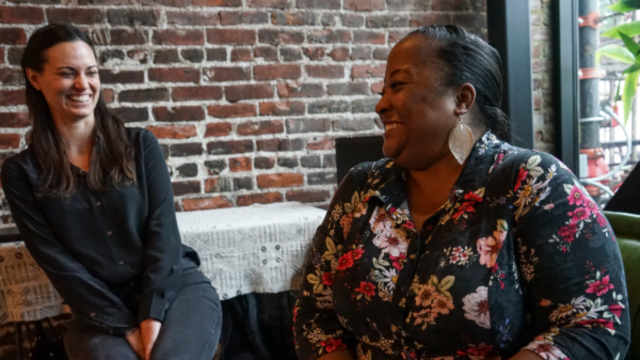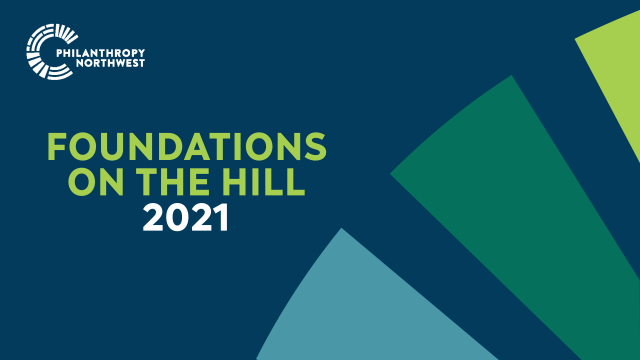Jeff Clarke, CEO
 “Public policy” is commonly defined as the system of laws, regulatory measures, courses of action and funding priorities for a given issue. Influencing public policy through education, advocacy and network activation is an ongoing process at the local, state and federal levels. It is the arena in which proponents and skeptics stake out positions with the ultimate goal of laws and regulations reflecting their respective values. To the victor goes the allocation of resources. For the philanthropic sector, policy includes laws and regulations affecting both specific issues and the charitable sector as a whole.
“Public policy” is commonly defined as the system of laws, regulatory measures, courses of action and funding priorities for a given issue. Influencing public policy through education, advocacy and network activation is an ongoing process at the local, state and federal levels. It is the arena in which proponents and skeptics stake out positions with the ultimate goal of laws and regulations reflecting their respective values. To the victor goes the allocation of resources. For the philanthropic sector, policy includes laws and regulations affecting both specific issues and the charitable sector as a whole.
How important is public policy to our sector? A recent Center for Effective Philanthropy report found that three quarters of surveyed foundation CEOs felt that the top barriers to their foundations’ ability to make progress are the current government policy and economic environments.
How important is policy to the Philanthropy Northwest community? It’s a widely held assumption that a credible philanthropic member network provides public policy leadership of some form to its network. In order for us to add value here, it is important that we understand our network’s commitment to and current work in public policy. In July, Philanthropy Northwest conducted its first-ever public policy survey across the six state region.
With a response rate of 22%, I am left wondering about this widely held assumption. Given that it was summer, perhaps the survey was poorly timed. Maybe the survey, with its 15 questions, was deemed too complex by some recipients, each of whom is likely to be frequently surveyed. On the other hand, perhaps the 22% response rate accurately reflects a low level of member interest in public policy.
While we may not yet have clear insight about network expectations, the Philanthropy Northwest team continues its commitment to policy leadership. In February, I shared observations about a public dust-up of sorts between two philanthropy colleagues. The source of conflict? Values, which are foundational elements of public policy. One colleague suggested that the sector wasn’t meeting its promise and as a result, Congress might be inclined to impose more regulation; the other argued that philanthropic freedom, as the basis of the sector, was best served by voluntary reflection and self-regulation. Different core values, different policy prescriptions.
In March, I described a flurry of national and state philanthropic sector reforms then under consideration, headlined by U.S. House Ways & Means Committee Chairman Dave Camp’s (R-MI) first cut at tax reform (including donor-advised fund reform). I concluded:
- Like politics, all philanthropy is ultimately local. While we are a region of large places, we have amazing access to our elected officials. We can and should use this access to consistently and clearly convey – through data supported human interest stories – how the collaborative nature of our work builds individual and local community resilience.
- While the states are the center of current policy action, our policy network must also remain totally engaged in the national dialogue which, while appearing stalled, never really sleeps.
Even knowing that the federal policy process never sleeps, many were still surprised this summer when the House of Representatives easily passed H.R. 4719, unexpected bipartisan legislation known as the America Gives More Act. Some called it the most important charitable legislation in decades, as it would directly impact individuals, private and community foundations, nonprofits and a range of other ecosystem players. For both the House and Senate, Philanthropy Northwest activated our network, asking members to contact their Congressional delegation to support the bipartisan legislation. We also partnered with our six state nonprofit association peers to speak to our delegations with a single voice. However, after a focused September appeal to Senate leadership to schedule and pass the bill, entropy reigned and Congress adjourned without action in the Senate.
So why do I return to the topic of public policy this month? Because the policy process never sleeps.
Tucked near the back of the September 11 issue of Chronicle of Philanthropy is an article entitled, “Conference to Debate Whether Current Charity Rules Promote the Public Good.” The invite-only conference, “Promoting Meaningful Reform in Philanthropy,“ took place ten days ago in Boston. Its primary organizer, Boston College law professor Ray Madoff, believes that “many people are frustrated by the way Congress sidesteps critical questions when it discusses philanthropy.” The ultimate goal of the conference – which was funded by foundations and, for a reform conversation driven by values / equity, completely overlooked diversity and inclusion – was to create momentum and support for the professor’s project, Forum on Philanthropy and the Public Good, which is intended to operate for five years to educate Congress about the following questions:
- “Should donors get a bigger tax benefit by giving to charities that help vulnerable people?”
- “Does the law adequately delineate what makes an organization charitable?”
- Did Chairman Camp’s tax reform proposal have it right by imposing on organizations administering donor advised funds a 20% excise tax on donor-advised monies undistributed to nonprofits after five years?
- Should private foundations be required to pay out at a rate higher than the current 5%?
- Should regulations allowing private foundation administrative expenses and contributions to donor-advised funds to count as annual payout be changed?
All are fair questions that deserve inclusive public debate. All are questions rooted in values. All are public policy questions. And, aside from Chairman Camp’s specific donor-advised fund proposal, all are questions that have been actively debated for at least a decade by Senate Finance Committee staff.
Lest we think that it’s only a lone professor and Senate Finance Committee staff, Gara LaMarche, a distinguished philanthropy colleague and current president of the Democracy Alliance, raised similar concerns in his recent article “Democracy and the Donor Class.” In tracing his own evolving perspective on philanthropy, he wrote:
[What the fiscal cliff crisis situation] made plain to me was not just that philanthropy is quite capable of acting like agribusiness, oil, banks, or any other special-interest pleader when it thinks its interests are jeopardized. It helped me see that however many well-intentioned and high-minded impulses animate philanthropy, the favorable tax treatment that supports it is a form of privatization. Money that would otherwise be available for tax revenue that could be democratically directed is shielded from public control for private use.
Calls for reform are not new and they are not going away. They are driven by disagreements about accountability, equity and transparency. For example, earlier this month, the Center for Effective Philanthropy released findings around some of its work on transparency with Foundation Transparency: Are Foundations and Nonprofits Seeing Eye to Eye?
It’s disheartening that nonprofit and foundation leaders – working partners – disagree to such an extent about the value and definition of transparency in their relationship. If this is the case, what assumptions should we make about those on the outside of the sector looking in? These types of disconnects ultimately become the substance of reform and play themselves out through the policy process.
We’ve been here before and we have a clear roadmap. The work of the Philanthropy Awareness Initiative showed the field that a significant awareness deficit exists with “engaged Americans.” PAI’s work points to an important opportunity for the sector to proactively engage, tell its story and, by extension, build awareness and influence to avoid the scenario articulated by Congressman Earl Blumenauer (D-OR): “If you don’t have a seat at the table, you are most certainly on the menu.”
If, in fact, philanthropic freedom rests upon and is best served by continuous reflection and self-regulation, then the time to live those values is now. I’ll assume this is why foundations supported the recent Boston conference. Will our broader sector engage in this conversation? If so, how? Do we perceive discussions about social values, transparency and accountability as a threat or do we welcome the chance to openly debate the role of philanthropy in our democracy?
I envision and would like to work with you to ensure that the Philanthropy Northwest community proactively embraces the values that underpin philanthropic freedom, actively seek outs out and works with reformers / skeptics, and engages in the continuous work of policy. It will require far more than 22% of our community to do this credibly.



Comments
Thank you for this essay. I
Thank you for this essay. I especially appreciate that you have connected public policy to foundation transparency, which is an issue at the internal, institutional policy level, even when not actively debated in the context of philanthropy reform. As the CEP report you linked to demonstrates, it is all too easy for foundation leadership to decide that they are doing well enough when it comes to transparency, while a majority of those in the rest of the ecosystem would disagree. This blind spot is a direct result of the independence of the sector. Foundation independence is commonly touted as a virtue, but it is the dependencies, or rather interdependencies, of social life that keep us accountable to each other and striving for excellence. In the internet age, accountability and transparency come to all economic sectors, with or without their cooperation, eventually. The philanthropy sector has not yet been subjected to the internet effect, but it is not immune to it in perpetuity. Now there are two nascent efforts to bring a Yelp-like dimension of crowdsourced review to philanthropy: InsidePhilanthropy.com and Philamplify.org. Meanwhile, it is only a matter of time before 990 reporting is done, as a requirement, online, making 990 data machine readable and thus accessible public for analysis and comment. This new scrutiny that comes, to some degree, from outside the grantmaker-grantee relationship, will result in public policy outcomes over a relatively short time frame. Institutional strategy and policy should factor these changes into their planning starting today. In other words, if philanthropy can't find its intrinsic motivations for opening up, extrinsic motivations are on their way.
For more on my take on these
For more on my take on these issues, here are the slides from a webinar I presented recently for Grant Managers Network, updated from a presentation I gave at their conference earlier this year. http://www.slideshare.net/njames79/philanthrogeek-gmn-142